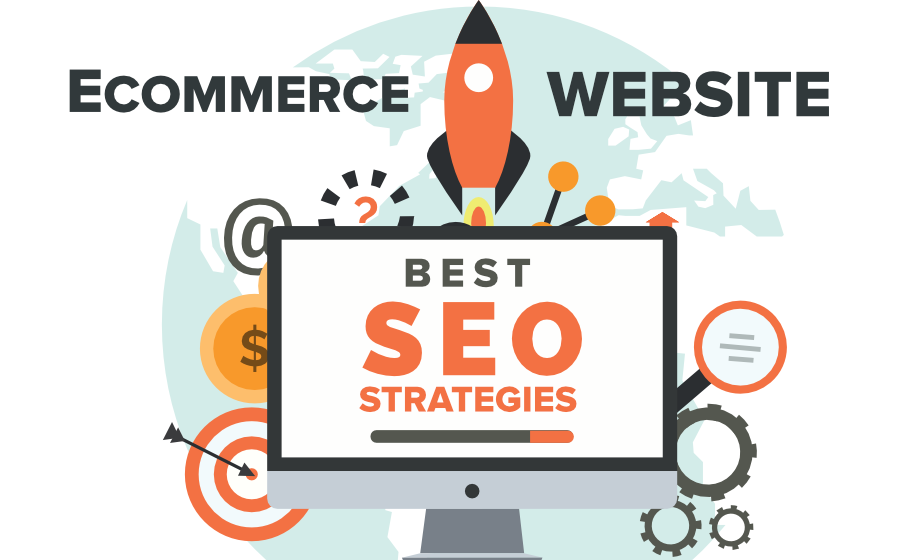eCommerce is a rapidly growing industry and businesses that want to stay competitive need to employ the best eCommerce strategies, including effective eCommerce marketing strategies. But what is eCommerce marketing, exactly? And what are the best strategies for engaging customers and driving sales through eCommerce channels?
This article will explore those questions and provide some actionable tips for optimizing your eCommerce marketing strategy. So, whether you’re just starting out in eCommerce or you’re looking to refine your current approach, read on for some valuable insights.
Table of Contents
What is eCommerce marketing?
eCommerce marketing is the process of drawing visitors to your website, persuading them to make an initial purchase, and then keeping those consumers around so they will start buying from you.

It’s significant to mention that eCommerce marketing involves much more than just driving traffic to your website. Moreover, you’ll need to enhance the overall online purchasing experience to encourage repeat sales.
Both social selling and mobile apps may fall under this category. No matter how or where a consumer completes a transaction, your ultimate objective is to provide a seamless, consistent digital experience for them.
Benefits of eCommerce marketing
While search engine optimization is often a major component of eCommerce marketing, the benefits of an effective strategy extend beyond SEO. A well-executed plan can result in natural mentions on popular social media platforms and third-party websites, enhancing your online presence and driving additional traffic to your website.
These organic mentions add an element of trust and credibility, as they are not paid advertisements or promotions. Additionally, these external sources can increase your visibility to new potential customers who may not have found you through search engines alone.
You may differentiate yourself from the competition, draw in new clients, and convert your existing clients into brand ambassadors with unique eCommerce website marketing.
How to develop an eCommerce marketing plan
To build a digital marketing plan for your online store, follow these five steps.
1. Set goals and objectives
You must first outline your aims and objectives in detail. You won’t be able to determine whether your marketing efforts are genuinely effective if you don’t. Your ultimate objective is undoubtedly to grow sales and profits, but when establishing your goals, be more specific.
Analyze your statistics carefully to identify areas with potential for organic development. To determine where you’re underperforming, look at important data like organic search traffic, conversion rates, average order value, and repeat buy frequency. Then, outline specific targets to enhance those metrics.
2. Identify the target audience
Be aware of your target market by giving a brief description of your target audience if you want your eCommerce marketing to be successful. In other words, to adjust your marketing techniques and platforms, you must comprehend who your target client is.

You are driven by this activity to become quite clear about your beneficiaries and your method of service. Depending on what you sell, you probably have a number of target market divisions. If you are a coffee roaster, for instance, you might sell both directly to consumers and to coffee cafes. As far as you can, try to exclude no important client segments from your target market.
3. Create buyer personas
You must develop buyer personas for each sector of your target market once you have determined who they are. Using buyer personas, you can give your target audiences a face and a personality. They assist you in better understanding your ideal clients so that you can promote them more successfully.
4. Map the customer journey
The customer journey is made up of all the brand touchpoints and interactions consumer experiences with your business. It comprises their initial exposure to a problem, analytical research, site visits, and interaction with your social media profiles.

You may better understand your audience by mapping out their client journey. You learn what drives people to act in the first place and what difficulties they run into when making a purchase. Along the route, you find out where they look for information and what queries they have.
The most critical step might be to list every customer touch point where you communicate with your audience, including your eCommerce website, social media, natural search results, Google advertisements, events, etc.
5. Determine customer lifetime value
Customer Lifetime Value (CLV) is the total amount of revenue generated by a customer over the course of their engagement with you. It covers their initial purchase as well as any additional purchases they make from you in the future.
CLV controls how much money you can spend on new customers. Your ability to invest more in acquiring new clients depends on how high your CLV is.
It assists you in determining your most lucrative consumer groupings. You may determine which customer categories are the most profitable by calculating their CLV. From there, you can concentrate on attracting and keeping more of those consumers.
Best eCommerce marketing strategies
The advice provided here is important if you’re looking to learn both the most cutting-edge and effective eCommerce marketing strategies for a site.
1. Create original product content
Making content for an eCommerce website is the first step in getting it up and running. Your chances of success will increase if you provide original, high-quality content that connects with your audience and encourages them to interact with you, buy from you, and expand your following.

Promoting original content is a fantastic approach to making a point, sparking a thought, and leaving a lasting impression on the user. Between content that engages individuals and that that works to prevent them, there is a narrow line.
Why not go the extra effort, put in a little extra work, and produce something that is actually compelling? It’s a long-lasting eCommerce website strategy. A well-written page or two can create benefits for years to come.
2. Content marketing
Your website’s content comprises content from the homepage, category pages, product pages, blog pages, and so on. On the other hand, content marketing is content that is intentionally designed to draw customers and is promoted to grab their attention.
No other eCommerce marketing strategies compare to effective eCommerce content marketing for generating more favorable attention, engagement, and long-lasting conversions. You can make sure that your audience consistently receives fresh content that is important to them by producing and advertising original content.
Make a list of the many sorts of content you want to produce by brainstorming with your team. This includes mailings, videos, and blog articles. Additionally, make sure you are making the most of your marketing budget by seeking advice from professionals and, where needed, outsourcing work. Also, invest in top-notch software, subscriptions, personnel, and team training.
3. Social media marketing
eCommerce social media marketing is a really efficient marketing strategy for an eCommerce website as it enables you to interact personally and openly with your consumers and market. You can use social media to increase website traffic, foster engagement, and conversation, and build a larger consumer base.

By using various social media channels, you may diversify your efforts and build a strong online presence. This eCommerce website marketing strategy will ultimately help you meet clients’ needs, developing your company over time.
4. Email marketing
Email marketing is one of the best ways to communicate with your consumer base, making it one of the best eCommerce website marketing strategies. The strategy has been around for a long time because it is effective.
However, you must be extremely careful about the content of your emails and who is included in your outreach. Include helpful information in your emails if you want to reach your audience as successfully as possible. Offer worthwhile promotions, personalize them as much as you can, and make the most of the chance to mingle.
The emails should be clear about your company and be open about what it is doing. They can include any events you are attending, new features, and goods. To measure your consumers’ interest and keep them reading your emails, you should relate to them on a personal level.
5. Search engine optimization (SEO) for eCommerce
Today’s Search Engine Optimization (SEO) requirements make it more crucial than ever to make sure your website is regularly updated with rich and relevant information, encourages a positive user experience (UX), and is optimized to be as error-free as possible.
Your website’s content should be thorough and trustworthy and give the audience information that’s valuable to their searches. For instance, if you own an online business that sells camping goods, it’s a good idea to offer comprehensive product information and perhaps even host areas of your website with extensive amounts of content that elaborates on camping, supplies, or related themes.

When users are searching for a specific term, search engines will recognize your website as a matching result if you use keywords in your content in a natural way. One of the best eCommerce marketing tactics you can use is search engine optimization because it is low-cost and has a high return on investment.
6. Pay-per-click advertising
The ad, the offer, and the landing page are the three fundamental components of any pay-per-click marketing campaign. If you want to keep the lead’s interest, all three must be in perfect harmony and coordination.
In order to move the visitor through your conversion funnel, the landing page needs to be a continuation of your advertisement and give the benefit that was promised in exchange for clicking on the ad.
If you want your terms to show up near the top of search engine results, they must also be customized. The rest of your eCommerce marketing plans will probably incorporate these keywords as well.
7. Optimize for mobile

In order to deliver a positive user experience (UX) for everyone, it is critical to take into account the needs of mobile users, who are starting to predominate the internet user base, particularly in eCommerce.
Visitors to your website want the entire experience; they don’t want to be taken to an app or a web version of it. Therefore, make sure you meet their expectations and work on improving your website so that it is totally responsive. Users who bounce off your site aren’t worth anything, thus UX effort is frequently the best eCommerce strategy you can utilize!
8. Optimize the website’s layout
Test your website’s design, text, and arrangement of conversion elements after launching or rebuilding your eCommerce site. You want to make sure that when clients visit your website, it’s straightforward and easy to check out, that they are motivated to purchase your stuff, and that it is clearly clear how to do so.
The language used on your landing and product pages, the language used in your conversion elements, and even the intentional position of icons and other elements should all be tested. For this, you can employ a number of usability testing techniques.
Additionally, you should set up a system for the analysis and optimization of conversion funnels. With this, you can utilize a funnel to organize the pages on your website and track how users navigate it.
You’ll discover that some funnel journeys and pages work better than others. To better understand the experiences of consumers that dropped and converted, you can also watch the session records of such users.
9. Humanize and personalize
The eCommerce business now has consumers as its dominant force and your company needs to stand out in a distinctive way. Because of this, it’s more crucial than ever to tailor your user experience (UX) to your target market’s requirements. This is a critical component of your eCommerce marketing strategies just as much as it is of your overall brand strategy.

Take the time to learn about your consumers to personalize your outreach efforts. People enjoy feeling unique, so if you remember to include personal touches like greeting prospects by name, posting videos and images of your staff, and being open about your business’s processes and procedures, you will gain a dedicated clientele.
To wrap up,
While there are many eCommerce marketing strategies you could use, we’ve outlined what we believe to be the best ones. If you want help implementing them or would like more information, please do not hesitate to contact us. Our team is passionate about helping businesses succeed online and would be happy to assist you in any way possible.











